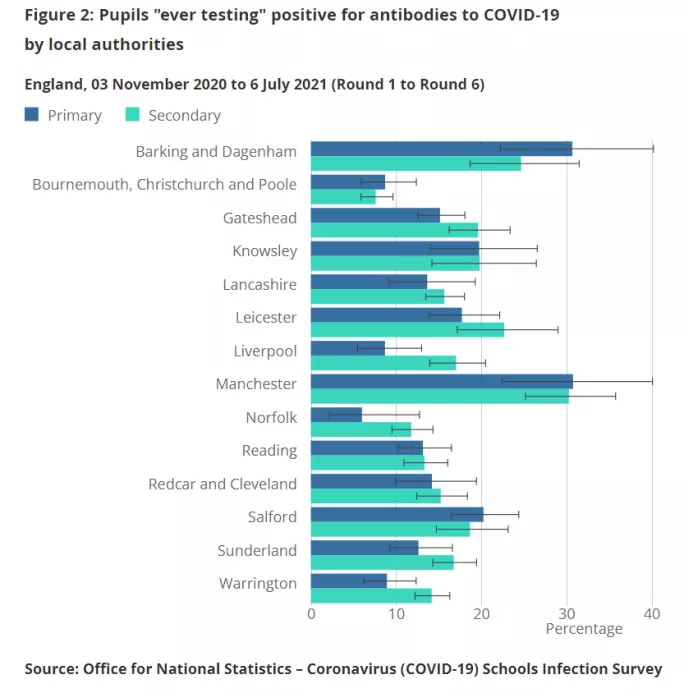Nearly one in three pupils are likely to have been exposed to Covid in some of the hardest-hit areas of the country, according to new data published this morning from the Office for National Statistics School Infection Survey (SIS).
In one London borough, Barking and Dagenham, where only 3 per cent of 12- to 15-year-olds had been vaccinated earlier this month, over 30 per cent of primary school pupils had Covid antibodies, suggesting prior infection.
Manchester also saw over 30 per cent of primary pupils infected over time according to the new data.
Revealed: 12-15 vaccine take-up just 3% in some areas
School absence: More than 200,000 pupils off because of Covid
Vaccination: Zahawi pushes student Covid jabs as virus cases soar
The study - which is jointly led by the London School of Hygiene and Tropical Medicine, the UK Health Security Agency and the Office for National Statistics - looked at the proportion of pupils “ever testing” positive for Covid antibodies between November 2020 and July 2021, using data from the SIS sampling 15 local authorities.
Calculating the proportion of pupils who had ever tested positive for Covid antibodies resulted in higher estimates of previous infection rates compared with results from the final “Round 6” of SIS tests, carried out between June and July 2021, the ONS said, as the oral saliva test used to check for antibodies was not as sensitive as a blood test.
Over the full course of tests, an estimated 15.3 per cent of primary pupils and 17.29 per cent of secondary pupils in local authorities sampled had at least one test recording antibody levels “above the limit of detection”.
The ONS said that the local authority estimates should be “interpreted with caution” as the confidence intervals - an indication of the degree of uncertainty of an estimate - for the data were wide, but that the data “indicated a wide range in antibody levels around the country”.
The data shows that pupil infection rates mirror community cases. In areas where community infection rates have been low, such as Bournemouth and Norfolk, the percentage of pupils who have ever tested positive for antibodies is lower than that in areas of high community infection, such as Manchester and Barking and Dagenham.
In 11 of the 14 local authorities, a higher proportion of secondary school pupils tested positive for antibodies than primary school pupils.
But in Barking and Dagenham, over 30 per cent of primary pupils had tested positive for antibodies over time, higher than the proportion of secondary pupils.
The study oversampled schools in “high prevalence” areas of the country, defined as areas in the top 20 per cent of confirmed Covid infection rates from 2 to 8 September 2020.
Low prevalence areas were defined as local authorities in the bottom 80 per cent for confirmed case rates per 100,000 in the same week.
Ten upper-tier local authorities were randomly sampled from the “high prevalence” group and five from the remaining “low prevalence” areas.





